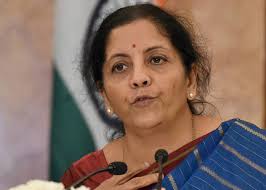 By Nageshwar Patnaik in Bhubaneswar, February 3, 2021: The union budget presented by Finance Minister Nirmala Sitharaman on Monday was a huge challenge with the Covid-19 pandemic leading to lockdown for more than two months virtually halting government revenue flows and steep hike in expenditure.
By Nageshwar Patnaik in Bhubaneswar, February 3, 2021: The union budget presented by Finance Minister Nirmala Sitharaman on Monday was a huge challenge with the Covid-19 pandemic leading to lockdown for more than two months virtually halting government revenue flows and steep hike in expenditure.
Revenue receipts collapsed from Rs 20.2 lakh crore to Rs 15.5 lakh crore, expenditure increased from Rs 30.4 lakh crore to Rs 34.5 lakh crore plunging the country to worst ever fiscal deficit. For this year, the Budget pegged the deficit at 9.5 per cent of Gross Domestic Product (GDP), much higher than market estimates of around 7 per cent and a 5 per cent-point rise over the previous year.
Sitharaman took a break from the tradition by not hiding the fiscal deficit numbers while offering a path to fiscal consolidation by FY 2025-26. Earlier Odisha took the lead by stressing on transparency in the Budget and it has done very well in terms of budget transparency index as compared to other states. She also took a big step bringing about transparency on the agri-food sector in the Union Budget. For years, a substantial part of the food subsidy was being put under the carpet by increasing the Food Corporation of India’s (FCI) borrowings pegged over Rs 3 lakh crore. No one believed that the budgeted figure of Rs 1,15,570 crore in the 2020-21 financial year reflected the true picture of this subsidy.
The FM has revised this figure to Rs 4,22,618 crore, a whopping increase of Rs 3,07,048 crore. The revised estimate (RE) for FY 2020-21 is 3.66 times the budgeted figure, indicating that almost all borrowings of FCI have been cleared. This is indeed a historic step towards introducing transparency in the Union Budget. And for FY 2021-22, the budgeted estimate is Rs 2,42,836 crore.
 The minister also needs to be hailed for clearing off the fertiliser industry’s arrears. Against the budgeted figure of Rs 71,309 crore for FY 2020-21, the revised estimate is Rs 1,33,947 crore, an increase of Rs 62,638 crore. For FY 2021-22, things are likely to smoothen with a budget provision of Rs 79,530 crore.
The minister also needs to be hailed for clearing off the fertiliser industry’s arrears. Against the budgeted figure of Rs 71,309 crore for FY 2020-21, the revised estimate is Rs 1,33,947 crore, an increase of Rs 62,638 crore. For FY 2021-22, things are likely to smoothen with a budget provision of Rs 79,530 crore.
The third highest expenditure in the agri-food space is that of the Pradhan Mantri Kisan Samman Nidhi (PM-Kisan), which decreased from Rs 75,000 crore in FY 2020-21 to a RE of Rs 65,000 crore; the same amount is now budgeted for FY 2021-22.
Indeed, tax revenues fell like never before during lockdown period. But the real hit to the Centre’s finances came from a fall in disinvestment receipts and bringing off budget expenditure back on to the budget. The budget has pegged disinvestment receipts from strategic sale of PSUs and the initial public offering of LIC has been pegged at Rs. 1,75,000 crore in 2021-22 (B.E.). However, it could mobilize a meager Rs. 32,000 crore from disinvestment during 2020-21 (R.E.). The FM undoubtedly overestimates disinvestment receipts in 2021-22 (B.E.).
The FM has made a positive move of monetising assets of the National Highway Authority of India, and other government undertakings such as the dedicated freight corridor assets of the Railways, the oil and gas pipelines of GAIL, IOCL and HPCL. Monetization of Government assets will add to the revenue.
Another positive outcome of the budget has been reintroduction of the Developmental Financial Institution (DFI) after the merger of erstwhile IDBI, increase in Contingency fund from Rs.500 crore to Rs.30,000 crore and transferring Stressed Asset of the Bank to dedicated Asset Reconstruction Companies (ARCs).
The fall in net tax revenue to the Centre is a mere 1% of the rise in fiscal deficit numbers. Second, most of the increase in expenditure outlays is driven by the food and fertiliser subsidy (around 80%). Increases in health accounted for 3.88%.
Most importantly, the share of states in the divisible pool of taxes fell from 32% in the budgeted estimates to 28.9% (Revised Estimates 2020-21). The total devolution to the States as % of Gross Tax Revenue (GTR) has declined from 32.36% in 2020-21 (B.E.) to 30.02% in 2021-22 (B.E.). For last couple of years, a declining trend in devolution of states shares in taxes has been witnessed. These budgetary trend conflicts with fiscal federalism as enshrined in the Constitution through successive Finance Commissions.
For instance, the devolution to Odisha is down from 1.50% of GTR 2020-21 (B.E.) to 1.36 % of GTR in 2021-22 (B.E.). Odisha’s share in shared tax is budgeted at Rs. 36,300 crore in 2020-21 (B.E). It is reduced drastically to Rs.25,460 crore in Revised Estimate. This is a shortfall of Revenue to Odisha Rs.10,840 crore. This is bound to worsen the re venue position of the state.
venue position of the state.
Significantly, it is capital spending that is slated to go up by 26 per cent to Rs 5.54 lakh crore over the current fiscal year’s revised estimate of Rs 4.39 lakh crore, which is 6.6 per cent higher than the original provision. In 2021-22 (B.E), 75.7% of gross borrowing is financing the Revenue Deficit and remaining 24.3% is financing capital expenditure.
What makes the Budget particularly bold are the proposals to increase the FDI limit in the insurance sector from the existing 49 per cent to 74 per cent and targeting of the privatisation of at least two state-owned banks and one general insurance company in 2021-22. This move comes at a time when the ruling party is already facing a challenge from the opposition to its farm reform laws. Pushing through the required amendments to the existing bank and insurance nationalisation acts may not be difficult in Parliament.
Nonetheless, the Budget will go down as the politically boldest budget of the Narendra Modi government since 2014 sans new populist schemes in the wake of the farmers’ protests and considerable COVID-19-induced income and job losses in the country’s informal workforce as well as middle classes. Also, there are no cuts or concessions for income tax-payers.



Leave a Reply
Be the First to Comment!